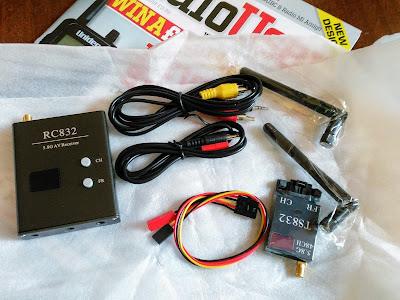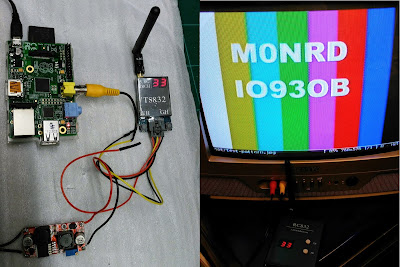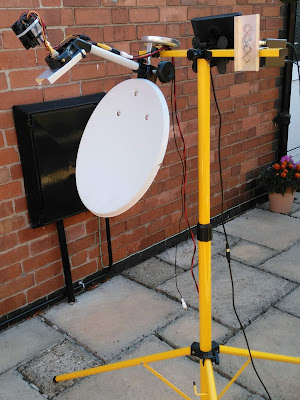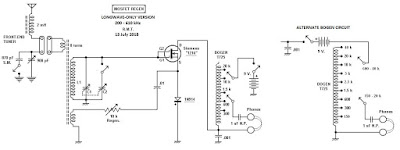 Moving Pictures! First dabbles in Amateur TV
Moving Pictures! First dabbles in Amateur TV
They say "a picture paints a thousand words"and I've always liked the idea of sending pictures via radio having dabbled with sending and receiving SSTV and SSDV, including pictures from High Altitude Balloons (HABs) like the Hamfest HAB flight I did back in 2015
But I've also been intrigued by "Fast scan TV" to transmit moving images. I've seen demonstrations at conferences and in online videos and joined the British Amateur Television Club BATC a few years ago but apart from reading the CQ-TV magazine I had not done anything mainly due to expense and investment I mistakenly thought I would need to make.
Recently I have seen mention of using easy and low cost equipment to get on the air on 5.6GHz (the 6 cm amateur band) using cheap modules intended to transmit “First Person Video” (FPV) back from drones.
These simple units can be used without any modifications to get on air. A number of operators have used them with high gain WiFi panel and/or dish antennas with a clear line of sight path to send pictures to stations using the same equipment over paths in excess of 50km, the current record is over 160km. Chris Leviston M0KPW has an excellent website describing his 5.6GHz system http://www.5-6ghz-atv.co.uk/ and there is more information at the BATC Wiki https://wiki.batc.org.uk/5.6_GHz
Inspired I ordered some kit from eBay a few weeks back, a receiver module and transmitter arrived quite quickly (no slow boat from China this time)
The equipment is powered by a 12V supply and input and output is a composite video signal and audio. It can be fed by a standard camera or video source but I dug out an old Raspberry Pi and soon had it generating and transmitting a test card with the required call sign overlay. The modules are channelised, the displayed 33 number is bank 3, channel 3 which is 5.665GHz selected by the BATC since it sits inside the amateur allocation,
Over the week I refined the Pi software, adding the Pi camera and various libraries in python to generate video with informational overlay, adding a GPS allowed calculation of the locator square when out portable. I have put it in a box (sorry no picture of that) and a switch to flip between live video and test card. I also had a bash at making some double biquad antennas. Regularly updating my twitter feed with various milestones (I recommend you follow me)
Pi sending live video via 5.6GHz with text overlay using pi camera and raspivid easy peasy.. pic.twitter.com/Fthfpbw0r0— Andrew Garratt M0NRD (@nerdsville) July 28, 2018
While browsing the BATC website for information I spotted that there was an ATV Academy workshop being organised by the Telford and District ARS, giving people the opportunity of finding out a bit more about ATV and people could bring along their equipment and projects for advice. So at the last minute I decided to go but because of the distance could only really go on the Saturday. But it was well worth it and a great day. I was made to feel welcome by everyone there and was able to show off my modest achievements on 5.6GHz and learned about the BATC Portsdown Transceiver and MiniTioune receiver projects, even buying the parts to build the receiver.Lol, wife looking suitably impressed by the Pi based image generator which flips between live feed and test card using switch pic.twitter.com/M6qnif5V0P— Andrew Garratt M0NRD (@nerdsville) August 3, 2018
The academy coincided with a BATC Activity weekend and they were going up to the summit of the nearby Long Mynd to operate on the Sunday. Since I wasn't there I had planned to go to a local high point to see if I could make contact with some of the other operators and stations and got the kit ready on a cheap lighting tripod. I was going to use an old portable satellite dish with one of my double biquads at the feed point.Having a great time learning all about ATV today, showing off my humble efforts pic.twitter.com/YTwEf7Sjdl— Andrew Garratt M0NRD (@nerdsville) August 4, 2018
The satellite dish is inverted because they are offset so when the dish is vertical they are actually pointing around 20 degrees upward towards the TV satellite (in the UK). So for terrestrial use with low elevation they work better inverted. (see here for better description of offset dishes)
I did venture out but I chickened out setting up due to a combination of a surprisingly busy road, fly tipping and very hot conditions. Due to the the fly tipping in the lay-by I didn't want to be seen getting stuff out of car boot! especially as a few cars had slowed down as they passed.
Nevermind I have ordered couple of cheap high-gain mesh dish antennas so when they arrive I will get out again and arrange some skeds, hopefully roping in some of the radio club.
In addition to the 5.6GHz stuff I have also taken possession of an ADALM-PLUTO SDR from Analog Devices. It is inexpensive (£90/$100) and designed to allow educational experimenting in software defined radio. It is a SDR receiver and low-power transmitter. They had been in short supply but availability has improved.
Charles Brain G4GUO has added support for the device into the DATV Express software. I am hoping to use it for some experiments in RB-TV (Reduced bandwidth TV) so I can actually use my NoVs
I took the PLUTO along to the ATV workshop and was able to see it transmitting and being received by other peoples receivers. So last night I got out the two satellite receivers I have and with a little bit of persuasion with settings got some DVB-S DATV transmitted and received.
Anyway, that is enough for now.. but will try to keep the blog updated as I experiment some more, but follow my twitter account @nerdsville for realtime updates 73 AndrewBit of "shaky cam" but shows the ADALM-PLUTO transmitting across the shack using #DATVExpress being received by an old FTA satellite box. pic.twitter.com/souCJA9qBK— Andrew Garratt M0NRD (@nerdsville) August 5, 2018
Andrew Garratt, MØNRD, is a regular contributor to AmateurRadio.com and writes from East Midlands, England. Contact him at [email protected].
 ICQ Podcast Episode 273 – Austrian Innovation
ICQ Podcast Episode 273 – Austrian Innovation
In this episode, Martin M1MRB is joined by Chris Howard M0TCH, Dan Romanchik KB6NU, Ed Durrant DD5LP and Frank Howell K4FMH to discuss the latest Amateur / Ham Radio news. Colin M6BOY rounds up the news in brief, and this episode’s feature is Austrian Innovation and US Book Review.
- RSGB Releasing New Amateur Radio Exam Syllabus
- Thailand 3rd Largest Ham Radio Nation
- RSGB Retires AROS and Implements OAS
- ARRL Board Adopts Volunteer Monitoring Program
- DAB Radio in Norway is a Tragedy!
- Parity Act Options Open Despite Removal from Defense
- Authorization Act Conference Report
- Spiders and Space Weather
- Sample Belgian Online Ham Radio Exams
- Online NASA Toolkit for Satellite Data
Colin Butler, M6BOY, is the host of the ICQ Podcast, a weekly radio show about Amateur Radio. Contact him at [email protected].
 Amateur Radio Weekly – Issue 213
Amateur Radio Weekly – Issue 213

ISS packet radio system back late this year
The currently silent packet radio system on the International Space Station could be back on the air by year’s end.
ARRL
Tutorial: Plot and decode weather balloon data
A radiosonde is a small weather sensor package that is typically attached to a weather balloon. As it rises into the atmosphere it measures parameters such as temperature, humidity, pressure, GPS location etc, and transmits this data back down to a receiver base station using a radio signal.
RTL-SDR.com
Edwin Armstrong’s Battle for FM Radio
It is a story of innovation, but also a story of personal vanity, corporate greed, stubbornness, marital problems, and even suicide. The only thing missing is a long-lost identical twin sibling to turn it into a full telenovela.
Hack A Day
Locating Sources Of Noise
As our lives become filled with technology, the likelihood of electronic interference increases. Every lamp dimmer, garage-door opener or other new technical “toy” contributes to the electrical noise around us.
Surrey Amateur Radio Club
Digital nets on 11m
Digital modes (ROS, FT8, SSTV, PSK31) are emerging on 11 meters.
Delta Alfa
Milliwatt DX on 868 MHz
Packets transmitted by the gateway of Ryan Walmsley, member of The Things Network East Coast, Great Yarmouth, was received 235 km away in Utrecht, Netherlands.
Southgate
Q&A: Summer of Tariffs
Will a 25 percent tariff be material on a single switch purchase costing a few dollars? Of course not. But this helps illustrate that once you start entering into the hundreds and thousands of dollars, these tariffs begin having an impact.
SparkFun
Ruth Willet is 2018 Hiram Percy Maxim Memorial Award recipient
The Hiram Percy Maxim Memorial Award is given annually by the board to a radio amateur under the age of 21 whose accomplishments and contributions to both Amateur Radio and the local community are of an exemplary nature.
ARRL
Video
QRP vs 20 Watts – What is the Practical Difference?
Running one hour in a contest at 5 watts, and the next hour at 20 watts.
Outdoors On The Air
Flight of the Bumblebees 2018
This is a popular QRP CW amateur radio event. The Bumblebees are portable stations.
N4KGL
Compact Homebrew End Fed QRP Antenna
I built this antenna specifically for low wattage QRP use to be compact and inexpensive. It utilizes a 9:1 unun wrapped on a T106-2 toroid and minimal hardware to be lightweight.
WI9LL
Get Amateur Radio Weekly in your inbox.
Sign-up here
Amateur Radio Weekly is curated by Cale Mooth K4HCK. Sign up free to receive ham radio's most relevant news, projects, technology and events by e-mail each week at http://www.hamweekly.com.
 LHS Episode #240: The Weekender XIV
LHS Episode #240: The Weekender XIV
 Hello and welcome to the 240th episode of Linux in the Ham Shack. In this episode, we outline some of the great amateur radio contests and special events, open source events and distributions, and wine, food and song you can partake of in the next fortnight. Oh no, I said fortnight. Get out there and participate in things and have a great couple of weeks.
Hello and welcome to the 240th episode of Linux in the Ham Shack. In this episode, we outline some of the great amateur radio contests and special events, open source events and distributions, and wine, food and song you can partake of in the next fortnight. Oh no, I said fortnight. Get out there and participate in things and have a great couple of weeks.
73 de The LHS Crew
Russ Woodman, K5TUX, co-hosts the Linux in the Ham Shack podcast which is available for download in both MP3 and OGG audio format. Contact him at [email protected].
 Double SOTA: Mosquito Peak and London Mountain
Double SOTA: Mosquito Peak and London Mountain
Mosquito Pass is a popular 4WD road in Colorado that takes you to 13,185 feet in elevation. It also provides access to two excellent SOTA summits, both over 13k feet: Mosquito Peak (W0C/SR-068) and London Mountain (W0C/SP-025). Joyce/K0JJW and I activated both summits on the same day. Fortunately, the weather cooperated nicely.

The Road
We drove the road to the pass from the east (via Highway 9, heading north out of Fairplay then turning west onto County Rd 12 / Mosquito Pass Road). Consult the Pike National Forest map for more detail.
We’ve driven over this pass many times over the years and the condition of the road has varied quite a bit. Right now, I’d call this a moderate 4WD road. You will find trail descriptions online that call Mosquito Pass “easy 4WD” but I think that information is out of date. Our stock Jeep Wrangler had no problem with it but I would not recommend driving the road with a Subaru-class crossover SUV.

Be aware that this road is closed by snow early in the fall and opens late in the summer. It is very unlikely to be passable in June and typically opens sometime in July. We decided to wait until August. Did I mention the road exceeds 13,000 feet in elevation? Check BushDucks for usually reliable pass information.
Mosquito Peak (W0C/SR-068)

At Mosquito Pass, we took an unmarked 4WD north towards Mosquito Peak. This road is not shown on the Pike National Forest map. The road was in good condition but is a narrow shelf road with limited opportunities to turn around. We parked the Jeep at an obvious turn-around spot and hiked on up the south ridge to the summit. No consistent trail, but a few cairns here and there. The one-way distance was about half a mile with 500 feet of vertical gain, so not very difficult.
It was quite windy on top so we hunkered down behind some rocks to provide some shelter. Using the Yaesu FT-90 transceiver and the 3-element Arrow 2m yagi, we worked these stations without much trouble: W0BV, N0EMU, KN0MAP, W0DLE, KD0VHD and W9GYA. Our best DX was N0EMU near Calhan, CO at about 100 miles.
London Mountain (W0C/SP-025)

To hike London Mountain, we drove back down the pass to the west end of the mountain and parked the Jeep at the point another 4WD road heads off to the south (see map). This road was gated closed and marked “no trespassing”.
We followed an obvious but unmarked trail leading from this small parking spot up the ridge of London Mountain. For the most part, we were able to follow this trail all the way to the summit. In a few spots it faded out but we stayed near the top of the ridge and always found it again. There were times when we really wondered if the trail’s route was the best option but it worked out fine. There are a few steep sections and places where we used our hands on rocks. The variety of rocks on this mountain (including marble) made it an interesting and fun hike. Following the top of the ridge also provided some ups and downs and many small false summits. The one-way distance is 0.85 miles with 600 vertical feet.
On top, we worked W0BV, W0DLE, N0EMU, KC0PBR, KN0MAP and KL7GLK on 2m FM. The wind dissipated a bit so it was more pleasant to hang out on this summit. We left the summit around 1 pm local with blue skies and a few puffy clouds all around.

These two summits are a great double-summit opportunity, as long as you have a capable 4WD vehicle. I suppose you could hike up the road but you probably can’t do both of the summits in one day.
73, Bob K0NR
The post Double SOTA: Mosquito Peak and London Mountain appeared first on The KØNR Radio Site.
Bob Witte, KØNR, is a regular contributor to AmateurRadio.com and writes from Colorado, USA. Contact him at [email protected].
 Barn Door CLE Regen Results
Barn Door CLE Regen Results

This past weekend's 'Barn Door' CLE' saw a lot of participation, in spite of the mid-summer doldrums and the universal nasty lightning noise.
After reading CLE-organizer Brian Keyte's interesting posting to the ndblist, describing his homebrew single transistor regenerative receiver, I was inspired enough to dig out the soldering iron and build one for myself.
The circuit widely described as a '1AD regen' was originally designed several years ago by crystal-radio guru Mike Tuggle out in Hawaii. Mike is widely known for his exquisitely designed "Lyonodyne" DX crystal radio, which inspired an entire decade of intense DX crystal radio building activity back in the late 90's.
 |
| Mike Tuggle's 'Lyonodyne' DX Crystal Radio |
His '1 Active Device' medium-wave regen consists of a handful of simple components and a MOSFET that is up to the task. His design was, and still is, being duplicated by many throughout the NDB DX listening community.
 |
| Mike's original 1AD regen |
Mike recently sent me the circuit diagram that he eventually settled with, showing two possible ways of extracting audio with the widely popular Bogen T725 output transformer.
My own version used Mike's output scheme on the right and the RF circuitry in Roelof Bakker and Steve Ratzlaff's modified version, shown below. I had to increase the tickler (feedback) winding from 4 turns to 11 turns in order to get any regeneration. With 11 turns, my regeneration kicked-in at about three-quarters from the end of the regen control. At some point in time, while testing, some of the leads from my Bogen T725 output transformer momentarily brushed against each other, smoking my FET. Upon replacing it with another BF966, the receiver was much hotter, with regeneration kicking-in very close to the start of the pot. I'm not sure if the first FET was already damaged or that there is enough variation from FET to FET (of the same type) to make some have more gain than others. Accidentally blowing up the FET proved beneficial in the end!
Although most users employ sensitive sound powered headphones with their regens, including myself, some use modern phones with an extra stage of audio, such as an LM386.
Although not nearly as pretty as Mike's regen, my own 1AD was built in an afternoon, just for the recent Barn Door CLE.
 |
| My own MW 1AD regen |
I later added a calibrated dial plate, breaking the segment from 200kHz to 550kHz into two separate bands, with calibration ~ +/- 1kHz so that I pretty much new where I was tuning at all times. This allowed me to target specific beacons and wait for them to fade up.
When first published, Mike suggested the BF966 MOSFET seemed to work well and I purchased five of them with the intention of someday building a 1AD for the NDB band. The purchase came in handy, as today, the BF966 is no longer available. Apparently the similar, and still available BF998 works well (from tests done by Steve Ratzlaff) but is now in an SMD package at just 18 cents! No doubt there are dozens of MOSFETS that will do the job and at these prices, experimenting with various devices would be a very worthwhile project.
When operating, the regen proved to be surprisingly sensitive, and by using my 10' x 20' loop, I was able to put my local pest (AP-378 kHz and 1/2 mile away) into a deep null so that its huge signal was no longer blocking the top half of the NDB band. The null allowed me to hear beacons within a few kHz of the blowtorch signal as shown below:
I ended up with 70 stations logged, including a couple of Alaskans, in spite of the horrendous lightning noise on all three nights. Doing another 'Barn Door CLE' in the middle of the quiet DX season would be much more exciting and several 1AD users have indicated an appetite for such an event. If you put something together please let me know as having an army of 1AD's ready to go would be a great incentive to schedule another Barn Door weekend!
Steve McDonald, VE7SL, is a regular contributor to AmateurRadio.com and writes from British Columbia, Canada. Contact him at [email protected].
 LHS Episode #239: Sighs, Sighs, Everywhere Sighs
LHS Episode #239: Sighs, Sighs, Everywhere Sighs
 Welcome to Episode 239 of Linux in the Ham Shack. In this episode, the hosts discuss updates to Ubuntu, amateur radio satellites, updates to WSTJ-X, the latest Linux kernel, security tools, AX.25, logging and much more. Thank you for listening!
Welcome to Episode 239 of Linux in the Ham Shack. In this episode, the hosts discuss updates to Ubuntu, amateur radio satellites, updates to WSTJ-X, the latest Linux kernel, security tools, AX.25, logging and much more. Thank you for listening!
73 de The LHS Crew
Russ Woodman, K5TUX, co-hosts the Linux in the Ham Shack podcast which is available for download in both MP3 and OGG audio format. Contact him at [email protected].




















